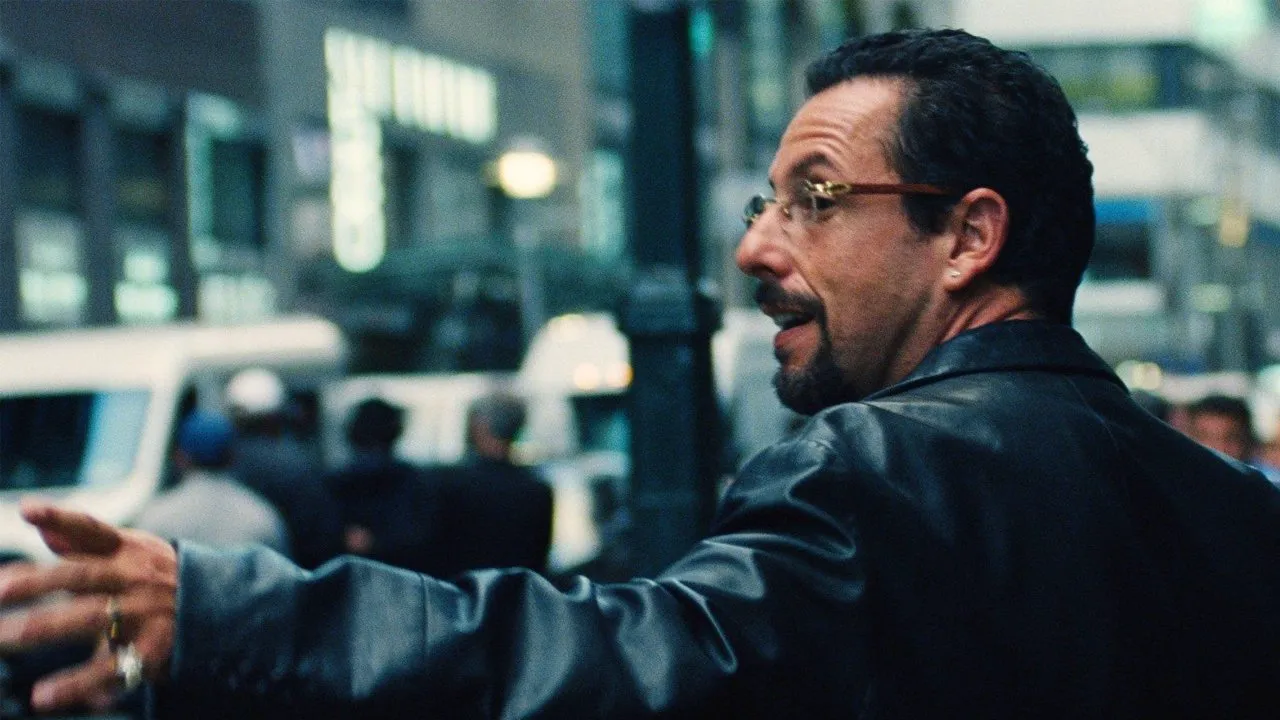Uncut Gems: A Two-Hour Panic Attack
In 2012, Howard Ratner (Adam Sandler), a jewelry store owner in New York’s Diamond District, is in deep. He borrows money at high interest rates, avoids collectors, and lives on the edge, convinced his luck is about to change. A rare opal, shimmering with every color imaginable and resembling a miniature universe, arrives from Ethiopia. Howard anticipates a fortune at auction, but NBA player Kevin Garnett appears, mesmerized by the opal. He borrows it for a crucial game, leaving his championship ring as collateral. Howard, sensing an opportunity, pawns the ring and bets everything on Garnett’s team.

The Safdie brothers have risen remarkably quickly from indie darlings to major filmmakers. This ascent occurred over just two films: 2017’s “Good Time,” starring Robert Pattinson, was a hit at Cannes, and in 2019, they solidified their success with “Uncut Gems,” a critical and commercial triumph (grossing nearly $50 million domestically). It was deservedly hailed as one of the year’s best films and even made several “best of the decade” lists.
From Indie to Mainstream (But Still Indie at Heart)
Accusing the Safdies of abandoning their indie roots for commercial success is difficult. Their films, even with stars like Pattinson and Sandler, fit organically into their cinematic universe of everyday New Yorkers: a greedy jeweler and a hapless thief complement their earlier characters like a pickpocket (“Pleasure of Being Robbed”), a struggling father (“Go Get Some Rosemary”), and a homeless addict (“Heaven Knows What”).

However, “Good Time” and “Uncut Gems” stand apart. They feature recognizable stars and move away from documentary-style filmmaking. The Safdies no longer simply capture reality; they create it. While “Good Time” felt like an acid-fueled odyssey, “Uncut Gems” is akin to a two-hour panic attack. It offers little respite, and its final act is a relentless assault, designed to leave viewers breathless and deeply uneasy.
The Safdie’s Unique Style
The Safdies achieve this intense immersion without flashy techniques like long takes, complex mise-en-scène, or heart-pounding music (Daniel Lopatin’s score is surprisingly measured). Instead, they rely on dynamic editing, Adam Sandler’s frenetic energy, and camerawork that often mimics surveillance. This creates the illusion that anyone could make a film like this. The truth is, few possess the Safdies’ mastery of pacing and rhythm.

Interestingly, the Safdies seem to disregard contemporary trends in art-house cinema, instead embracing the traditions of American independent film. They draw inspiration from their favorite movies, crafting something both familiar and fresh. “Uncut Gems” clearly nods to 1970s films like Martin Scorsese’s “After Hours,” Karel Reisz’s “The Gambler,” and William Friedkin’s “Sorcerer.” However, its primary influence is John Cassavetes’ “The Killing of a Chinese Bookie,” a crime masterpiece by their “teacher” and favorite director.

Homages and Originality
Cosmo, the strip club owner in “The Killing of a Chinese Bookie,” views his business as an art form, constantly striving for new heights, much like Howard. Both characters are romantics and maximalists who refuse to play by the gangsters’ rules and risk everything. Unlike other filmmaking siblings like the Duffer brothers, who create “Stranger Things” as a pastiche of 1980s favorites, the Safdies understand that inspiration is merely a foundation upon which to build their own legacy.
It’s no surprise that they achieve this ambitious goal with the help of actors like Robert Pattinson and Adam Sandler, whose new films generate significant buzz. Sandler has proven his talent in the hands of skilled directors (“Punch-Drunk Love,” “The Meyerowitz Stories”), but his performance in “Uncut Gems” is arguably his best. He embodies the greedy, insatiable jeweler who can’t stop himself.
Sandler convincingly cries, groans, gets punched, and yells at the TV, but his presence fundamentally alters the film’s atmosphere. He’s a walking force of chaos, setting everything around him in motion. The fact that his performance was overlooked during awards season is baffling to many, and it will likely be seen as another misstep by the Academy in years to come.